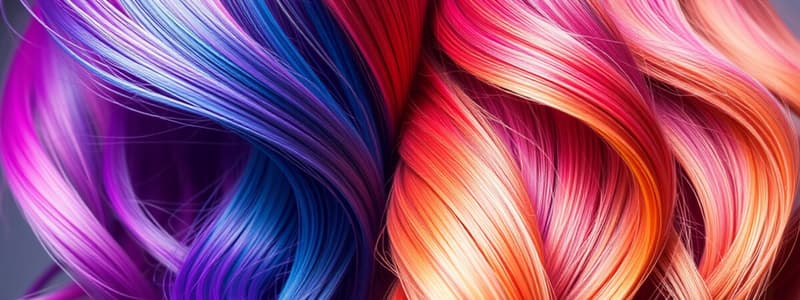Podcast
Questions and Answers
What is the primary purpose of lighteners in hair coloring?
What is the primary purpose of lighteners in hair coloring?
- To remove all types of hair dye
- To darken existing hair color
- To enhance hair texture
- To create a new lighter color foundation (correct)
Which factor is NOT considered when achieving the desired shade of lightness?
Which factor is NOT considered when achieving the desired shade of lightness?
- Resulting porosity
- Desired hair length (correct)
- Processing and development time
- Existing hair color
Which type of lightener is the mildest and can only lift one or two levels?
Which type of lightener is the mildest and can only lift one or two levels?
- Powder lighteners
- Oil lighteners (correct)
- Cream lighteners
- Gel lighteners
What should be used to determine the lightener previously applied during a retouch?
What should be used to determine the lightener previously applied during a retouch?
Which statement about cream lighteners is true?
Which statement about cream lighteners is true?
Which lightener type is suitable for removing undesirable casts and off-shades?
Which lightener type is suitable for removing undesirable casts and off-shades?
What is the maximum number of activators that can be added to cream lighteners for on-the-scalp application?
What is the maximum number of activators that can be added to cream lighteners for on-the-scalp application?
Which application method is commonly used for a lightener retouch?
Which application method is commonly used for a lightener retouch?
What is one of the main considerations when achieving desired shade of lightness?
What is one of the main considerations when achieving desired shade of lightness?
Which type of lightener is suitable for use directly on the scalp?
Which type of lightener is suitable for use directly on the scalp?
What is the term used when a lightener is applied only to new hair growth?
What is the term used when a lightener is applied only to new hair growth?
Which of the following is a characteristic of powder lighteners?
Which of the following is a characteristic of powder lighteners?
What should be referred to for determining how long to process the lightener?
What should be referred to for determining how long to process the lightener?
What is the maximum number of activators that can be added to cream lighteners for off-the-scalp processes?
What is the maximum number of activators that can be added to cream lighteners for off-the-scalp processes?
Which type of lightener is considered the mildest?
Which type of lightener is considered the mildest?
What can cream lighteners do during application?
What can cream lighteners do during application?
What is the purpose of lighteners in hair coloring?
What is the purpose of lighteners in hair coloring?
Which of the following can cream lighteners do?
Which of the following can cream lighteners do?
What should be considered when achieving the desired shade of lightness?
What should be considered when achieving the desired shade of lightness?
Which type of lightener is considered too strong to use directly on the scalp?
Which type of lightener is considered too strong to use directly on the scalp?
What does lightener retouch specifically involve?
What does lightener retouch specifically involve?
What should be referenced to determine the processing time for desired lightness?
What should be referenced to determine the processing time for desired lightness?
What is the maximum number of activators that can be added to cream lighteners for off-the-scalp processes?
What is the maximum number of activators that can be added to cream lighteners for off-the-scalp processes?
Which of the following is a function of hair lighteners?
Which of the following is a function of hair lighteners?
What is the primary function of lighteners in hair coloring?
What is the primary function of lighteners in hair coloring?
Which factor is NOT relevant in achieving the desired shade of lightness?
Which factor is NOT relevant in achieving the desired shade of lightness?
What is a key characteristic of cream lighteners?
What is a key characteristic of cream lighteners?
What distinguishes powder lighteners from cream lighteners?
What distinguishes powder lighteners from cream lighteners?
What does the term 'lightener retouch' refer to?
What does the term 'lightener retouch' refer to?
How many activators can be added to cream lighteners for off-the-scalp applications?
How many activators can be added to cream lighteners for off-the-scalp applications?
Which type of lightener is recognized as the mildest and used for one or two levels of lift?
Which type of lightener is recognized as the mildest and used for one or two levels of lift?
What should be used to guide the processing time for achieving the desired shade of lightness?
What should be used to guide the processing time for achieving the desired shade of lightness?
What is the purpose of hair lighteners?
What is the purpose of hair lighteners?
Which factor is essential when selecting a lightener?
Which factor is essential when selecting a lightener?
Which type of lightener is considered too strong for on-the-scalp use?
Which type of lightener is considered too strong for on-the-scalp use?
What does lightener retouch primarily involve?
What does lightener retouch primarily involve?
Which of the following statements about cream lighteners is true?
Which of the following statements about cream lighteners is true?
What is the mildest type of lightener?
What is the mildest type of lightener?
What should be considered when achieving the desired shade of lightness?
What should be considered when achieving the desired shade of lightness?
How many activators can be added to cream lighteners for off-the-scalp processes?
How many activators can be added to cream lighteners for off-the-scalp processes?
Study Notes
Double-Process Haircoloring
- Involves two distinct steps to achieve the desired hair color.
Lighteners
- Created to establish a lighter color foundation than the client's natural hair color.
- Can serve as a finished result or a preliminary step in a double-process application.
- Key considerations for achieving the desired lightness:
- Existing hair color
- Processing and development time
- Resulting porosity of the hair
- Selection of the desired color
Applications of Hair Lighteners
- Lighteners can be used to:
- Lighten the entire head or specific sections of hair.
- Achieve a targeted shade or stage of lightness.
- Brighten or enhance an existing shade.
- Remove unwanted tones or casts.
- Correct dark spots or streaks in previously lightened hair.
Selection of Lighteners
- Follow manufacturer's directions along with these general guidelines:
- Cream Lighteners:
- Suitable for on-scalp applications (virgin or retouch services).
- Provide some hair protection and control during application.
- Help neutralize unwanted red and gold tones.
- Can incorporate up to three activators for on-scalp use and four for off-scalp processes.
- Powder Lighteners:
- Strong enough for multiple stages of lightening.
- Caution required; often not suitable for direct scalp application.
- Oil Lighteners:
- Mildest option, ideal for achieving one or two levels of lift.
- Cream Lighteners:
Lightener Retouch
- Refers to applying lightener solely to new hair growth for color matching.
- Use the client's record card to guide:
- Previously used lightener type.
- Required processing time for achieving the desired lightness.
Double-Process Haircoloring
- Involves two distinct steps to achieve the desired hair color.
Lighteners
- Created to establish a lighter color foundation than the client's natural hair color.
- Can serve as a finished result or a preliminary step in a double-process application.
- Key considerations for achieving the desired lightness:
- Existing hair color
- Processing and development time
- Resulting porosity of the hair
- Selection of the desired color
Applications of Hair Lighteners
- Lighteners can be used to:
- Lighten the entire head or specific sections of hair.
- Achieve a targeted shade or stage of lightness.
- Brighten or enhance an existing shade.
- Remove unwanted tones or casts.
- Correct dark spots or streaks in previously lightened hair.
Selection of Lighteners
- Follow manufacturer's directions along with these general guidelines:
- Cream Lighteners:
- Suitable for on-scalp applications (virgin or retouch services).
- Provide some hair protection and control during application.
- Help neutralize unwanted red and gold tones.
- Can incorporate up to three activators for on-scalp use and four for off-scalp processes.
- Powder Lighteners:
- Strong enough for multiple stages of lightening.
- Caution required; often not suitable for direct scalp application.
- Oil Lighteners:
- Mildest option, ideal for achieving one or two levels of lift.
- Cream Lighteners:
Lightener Retouch
- Refers to applying lightener solely to new hair growth for color matching.
- Use the client's record card to guide:
- Previously used lightener type.
- Required processing time for achieving the desired lightness.
Double-Process Haircoloring
- Involves two distinct steps to achieve the desired hair color.
Lighteners
- Created to establish a lighter color foundation than the client's natural hair color.
- Can serve as a finished result or a preliminary step in a double-process application.
- Key considerations for achieving the desired lightness:
- Existing hair color
- Processing and development time
- Resulting porosity of the hair
- Selection of the desired color
Applications of Hair Lighteners
- Lighteners can be used to:
- Lighten the entire head or specific sections of hair.
- Achieve a targeted shade or stage of lightness.
- Brighten or enhance an existing shade.
- Remove unwanted tones or casts.
- Correct dark spots or streaks in previously lightened hair.
Selection of Lighteners
- Follow manufacturer's directions along with these general guidelines:
- Cream Lighteners:
- Suitable for on-scalp applications (virgin or retouch services).
- Provide some hair protection and control during application.
- Help neutralize unwanted red and gold tones.
- Can incorporate up to three activators for on-scalp use and four for off-scalp processes.
- Powder Lighteners:
- Strong enough for multiple stages of lightening.
- Caution required; often not suitable for direct scalp application.
- Oil Lighteners:
- Mildest option, ideal for achieving one or two levels of lift.
- Cream Lighteners:
Lightener Retouch
- Refers to applying lightener solely to new hair growth for color matching.
- Use the client's record card to guide:
- Previously used lightener type.
- Required processing time for achieving the desired lightness.
Double-Process Haircoloring
- Involves two distinct steps to achieve the desired hair color.
Lighteners
- Created to establish a lighter color foundation than the client's natural hair color.
- Can serve as a finished result or a preliminary step in a double-process application.
- Key considerations for achieving the desired lightness:
- Existing hair color
- Processing and development time
- Resulting porosity of the hair
- Selection of the desired color
Applications of Hair Lighteners
- Lighteners can be used to:
- Lighten the entire head or specific sections of hair.
- Achieve a targeted shade or stage of lightness.
- Brighten or enhance an existing shade.
- Remove unwanted tones or casts.
- Correct dark spots or streaks in previously lightened hair.
Selection of Lighteners
- Follow manufacturer's directions along with these general guidelines:
- Cream Lighteners:
- Suitable for on-scalp applications (virgin or retouch services).
- Provide some hair protection and control during application.
- Help neutralize unwanted red and gold tones.
- Can incorporate up to three activators for on-scalp use and four for off-scalp processes.
- Powder Lighteners:
- Strong enough for multiple stages of lightening.
- Caution required; often not suitable for direct scalp application.
- Oil Lighteners:
- Mildest option, ideal for achieving one or two levels of lift.
- Cream Lighteners:
Lightener Retouch
- Refers to applying lightener solely to new hair growth for color matching.
- Use the client's record card to guide:
- Previously used lightener type.
- Required processing time for achieving the desired lightness.
Double-Process Haircoloring
- Involves two distinct steps to achieve the desired hair color.
Lighteners
- Created to establish a lighter color foundation than the client's natural hair color.
- Can serve as a finished result or a preliminary step in a double-process application.
- Key considerations for achieving the desired lightness:
- Existing hair color
- Processing and development time
- Resulting porosity of the hair
- Selection of the desired color
Applications of Hair Lighteners
- Lighteners can be used to:
- Lighten the entire head or specific sections of hair.
- Achieve a targeted shade or stage of lightness.
- Brighten or enhance an existing shade.
- Remove unwanted tones or casts.
- Correct dark spots or streaks in previously lightened hair.
Selection of Lighteners
- Follow manufacturer's directions along with these general guidelines:
- Cream Lighteners:
- Suitable for on-scalp applications (virgin or retouch services).
- Provide some hair protection and control during application.
- Help neutralize unwanted red and gold tones.
- Can incorporate up to three activators for on-scalp use and four for off-scalp processes.
- Powder Lighteners:
- Strong enough for multiple stages of lightening.
- Caution required; often not suitable for direct scalp application.
- Oil Lighteners:
- Mildest option, ideal for achieving one or two levels of lift.
- Cream Lighteners:
Lightener Retouch
- Refers to applying lightener solely to new hair growth for color matching.
- Use the client's record card to guide:
- Previously used lightener type.
- Required processing time for achieving the desired lightness.
Studying That Suits You
Use AI to generate personalized quizzes and flashcards to suit your learning preferences.
Description
Explore the intricacies of double-process haircoloring in this quiz. Learn about the importance of lighteners in achieving a desirable shade and the essential steps involved in the process. This quiz will enhance your understanding of hair coloring fundamentals and procedures.





